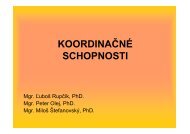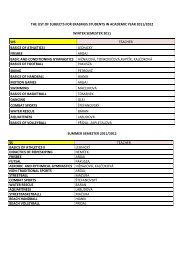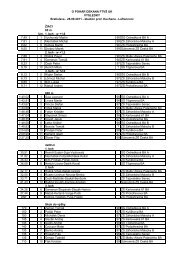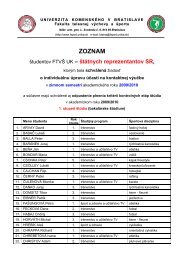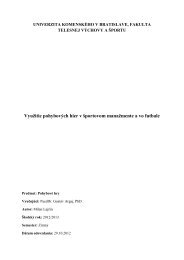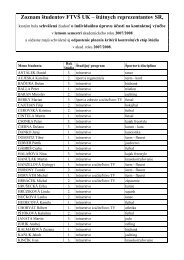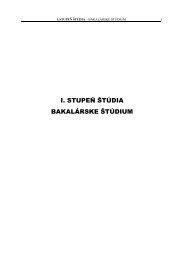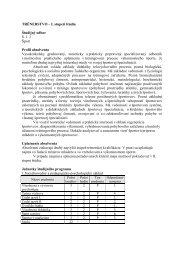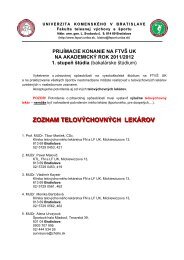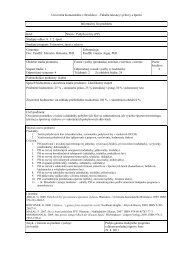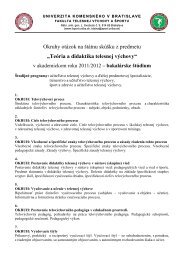acta facultatis educationis physicae universitatis comenianae
acta facultatis educationis physicae universitatis comenianae
acta facultatis educationis physicae universitatis comenianae
Create successful ePaper yourself
Turn your PDF publications into a flip-book with our unique Google optimized e-Paper software.
The subjective exercise experiences and aesthetic activities<br />
5<br />
THE SUBJECTIVE EXERCISE EXPERIENCES<br />
AND AESTHETIC ACTIVITIES<br />
Durdica Miletic<br />
Faculty of Kinesiology, University of Split, Croatia<br />
Summary: The investigation was conducted in order to provide evidence of reliability and<br />
validity of the Subjective Exercise Experiences Scale (SEES) and identify the differences in<br />
SEES subscales before and after physical activity in a group of university students involved in<br />
aesthetic (N = 69) and non-aesthetic (N = 67) activities. The internal consistency (Cronbach<br />
alpha coefficient) of the items assigned to each of the three SEES subscales were high and<br />
satisfactory (0.83 to 0.85). According to post-hoc Fisher LSD test, the significant differences<br />
in SEES subscales among groups were found in Fatigue and Positive Well-Being (PWB) and<br />
depended t-test showed significant differences before and after physical activity in PWB only in<br />
aesthetic group. Opposite of the general opinion that male students do not enjoy aesthetic<br />
movement classes, the results suggested that those classes affect them in a positive way. It is<br />
possible that music increased emotionally experienced activity and contributed to better physical<br />
well being. This is the first research that has reported subjective exercise experience effects of<br />
aesthetic activities on male student population.<br />
Key words: well being, male students, PE curriculum<br />
Introduction<br />
Many studies appoint the psychological benefits of exercise (North, McCullagh & Tran,<br />
1990; Plante & Rodine, 1990; Petruzzelo, Landers, Hatfield, Kubitz & Salazar, 1991) and<br />
measures for global psychological responses to the stimulus properties of exercise were<br />
constructed (Mc Auley & Courneya, 1994). However, the influence of various styles of<br />
activities, especially effects of aesthetic activities on male student’s population was not<br />
investigated yet.<br />
The psychological or mental health is generally acknowledged to comprise affective<br />
states or psychological distress (e.g., anxiety, depression, stress-related emotions) and psychological<br />
well being (Stewart & King, 1991; Leight & Tailor, 1990). Well-known measures<br />
for assessing both negative and positive affective states are Profile and Mood States – POMS<br />
designed by McNair, Lor, & Droppleman (1971); the Positive and Negative Affect Schedule<br />
– PANAS, investigated by Watson, Clark, & Tellegan (1988); Feeling Scale – FS, by Rejeski,<br />
Best, Griffith & Kenney (1987); and Subjective Exercise Experiences Scale – SEES designed<br />
by Mc Auley & Courneya (1994). The latest measure, Subjective Exercise Experiences Scale<br />
(SEES), was chosen for current investigation because of relative shortness in final version<br />
and the way in which the initial construction of this measurement was made. The first 367<br />
Acta Facultatis Educationis Physicae Universitatis Comenianae LII/I



